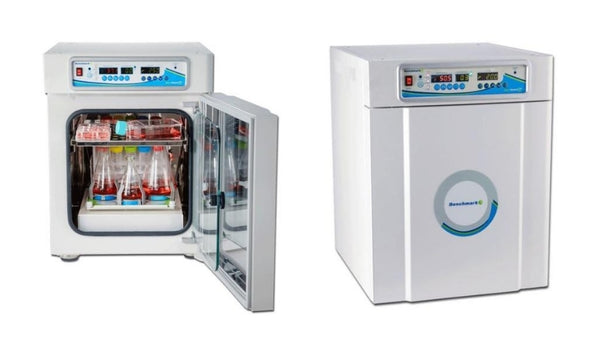Incubated orbital shakers and shaking water baths appear to offer essentially the same things: simultaneous incubation and agitation with an orbital shaking motion. You may wonder why there are two distinct pieces of equipment. Perhaps you have one or the other in the lab and are hoping they can be used interchangeably so you don’t need a second piece of equipment. Or you may be deciding which is the right one to purchase for your application.
In this post, we look at the differences between the two to help make the decision more straightforward.
The Main Difference: Thermal Transfer
The major difference between these two pieces of equipment is the efficiency of the heat transfer to your samples. In a shaking water bath, samples are surrounding by water, an excellent conductor of heat. In an incubated shaker, they are surrounded by air, an insulator.

An Incu-Shaker™ 10L and a SW Series Shaking Water Bath.
An incubator will heat up samples slowly and gradually. This is important in certain applications, for example, where there is a risk of heat-shocking sensitive cell cultures.
On the other hand, if there is no such concern and you want quick heat transfer, then a shaking water bath may be a better option.
If you’re stuck with using a shaking water bath instead of an incubated shaker, you could ramp up the temperature slowly to avoid damaging samples. Additionally, if you are applying a protocol from a shaking incubator to incubation with a shaking water bath, and the process calls for incubation for a certain amount of time, you may have to use trial and error to shorten that period.
It’s worth noting that one more benefit of better thermal transfer is that shaking water baths will hold their temperature better than an incubated shaker if the lid is opened.
Other Things to Consider
Although heat transfer is the main difference, there are other factors to consider:
Temperature Range
Both shaking baths and incubated shakers can give you temperatures up to around 80°C. Incubated shakers often have refrigeration too, but typically won’t go lower than 15°C.
Shaking water baths sometimes come with the option of refrigeration and can offer lower temperatures, some going down to 0°C.
CO2 Control
Another standout consideration is CO2. Some incubated orbital shakers offer you the ability to control the level of CO2 in the chamber. This is important for some applications, such as mammalian cell culture, as it enables you to control the pH of the sample medium. This is simply not an option for shaking water baths, so if CO2 control is necessary, you’ll need a CO2 incubated shaker.

The Incu-Shaker™ CO2 Mini enables you to control the level of CO2.
Cleanliness
Shaking water baths create a moist, humid environment, which is a perfect breeding ground for bacteria, so they are less suitable for applications requiring a sterile environment.
You also have to change the water on a regular basis and keep it topped up, but there is no such requirement of upkeep for an incubated orbital shaker.
Price
One more factor to consider, but a very important one, is cost. If you have one of the pieces of equipment already in the lab, and none of the above considerations prevent you from using it for your application, then you might be able to avoid buying a new piece of equipment.
If you’re deciding between purchasing one or the other, then you may look at the cost of each unit. When you account for size, shaking water baths will tend to be more expensive than incubated orbital shaker.

Take these two units produced by the same manufacturer, Benchmark Scientific. The SB-12L Shaking Water Bath on the left costs $2,377. It can hold up to four 250 mL bottles or three 250 mL flasks.
The Incu-Shaker™ Mini incubated orbital shaker on the right costs a little more ($2,437 or $2,751 if you add the appropriate MAGic Clamp™ platform). However, this unit can hold up to eight 250 mL flasks at a time.
